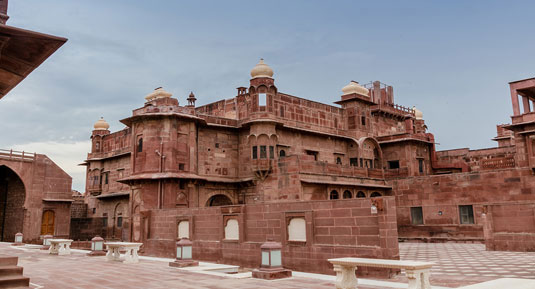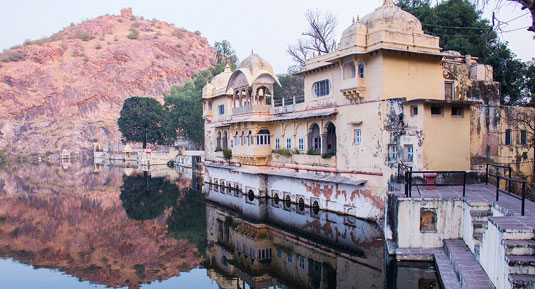EXPLORING JODHPUR: THE FORTIFIED CITY OF RAJASTHAN
Situated amidst the sandstone hills of Rajasthan Jodhpur is the second largest city of India, after Jaipur. The city was named after Rao Jodha, a ruler belonging to the Mandore clan. Perched at the height of two-thirty meters above the sea level, Jodhpur has been the capital city of the Rathod and Marwar kings during the fourteenth century. This is the primary reason behind the magnificent forts, grandiose palaces and wonderfully infrastructured lakes that Jodhpur is famous for.
According to historical records, in the sixteenth century, a wall stretching up to ten kilometres was built around the city. This majestic wall that surrounds Jodhpur was initially built to protect it from the adversities of sand storms. This fortification is one of many factors that makes Jodhpur a very unique city in the eyes of potential tourists.
Another striking feature of Jodhpur is the generous dispersion of the colour blue throughout the city. All the houses and buildings of Jodhpur are whitewashed with their roofs painted blue. It looks as if it’s a reflection of the sky above. It is because of this exceptional attribute that Jodhpur has acquired the title of the ‘Blue city of India’.
It is commonly believed that all the residences of Jodhpur are painted white with a tinge of cobalt blue as a measure to protect them from the sun. This unique and dominant colour scheme adds to the city’s beauty and garners sightseers from all across the world. Owing to its location amidst the Thar desert, the temperature of Jodhpur highly fluctuates on a daily basis. Due to this climatic condition, the suitable period for one to visit Jodhpur is between October to March.
Everything about Jodhpur exudes the aura of ethnicity and royalty. This city is also known for its rich tie and dye work. This artwork known as ‘bandhini’ is done on various fabrics and is a native craft work of Jodhpur. The artisans skilled at bandhini have acquired this craftsmanship from their ancestors who have been passing on the technique for generations. It mainly involves carefully tying up fabrics with threads or beads and dyeing them.
The tied-up portions form intricate designs of another colour. Bandhini is one of the popular products of Jodhpur that tourists prefer to take back as souvenirs. Some markets that sell bandhini home decor and apparels are Nai Sarak Market, Sojati Gate Market and Sadar Market, to name a few.
Another product of Jodhpur that draws in buyers and dealers from across the world is its native footwear. Jodhpur Jutis or Mojris are the traditional shoes fashioned for the Jodhpur royalty. These footwears are bejewelled and handcrafted exclusively to match the traditional Jodhpuri suits. The Mojris abound in colour and successfully catches the eyes of any onlooker. The one attribute that renders these shoes a princely look is the unique design comprising detailed embroidery work or patterns of beads.
Mojris is an original Jodhpuri product which is imported worldwide. The handiwork of Jodhpur’s local Juti- makers attracts fashion students, artists, fashion enthusiasts and fanciers from India and abroad alike. A visit to Jodhpur is incomplete without the purchase of a wondrous pair of Mojris. It is something which you would get at a wholesale rate in the blue city unlike the high rates of the imported ones.
Blank space
The market places where Jodhpuri Jutis are always at the sale are the Mochi Bazaar in the walled city or Jutti Corner on Station Road.
Jodhpur is a paradise of curios and many other arts and craft product that represent the rich culture of the city. In Jodhpur, you can find and purchase objects of great antiquity like royal artefacts, marble figurines, aesthetic wall paintings, fancifully carved woodwork and furniture, rare fabrics, authentic silverware and jewellery, wooden toys, sculptures and puppets. Ancient books and pictures of the royal ancestors, wildlife and other interesting events of the previous era are also put out for sale. Mercantile establishments, such as the Sun City Art Exporters, Rajasthan Art Emporium, Rajasthan Arts and Crafts House.
Apart from Jodhpur’s scenic beauty and craftwork, another feature that garners worldly renown is its cuisine. Jodhpur is famous for its traditional vegetarian food that mainly comprises lentils and pickled vegetables. One of the most popular platters that are served in Jodhpur is the Rajasthani thali. In a royal thali, one would find an assortment of curries, pickles and bread.
The food of Jodhpur is by and large affected by aridness of the place. Dal Bati churma, gatte ki sabzi, and Missi roti are few of the good staple items one would definitely find on their plates. While in Jodhpur, one of the best things to experience is the divine flavour of a drink known as makkhan lassi. This drink consists of sweetened buttermilk with heaps of pure Desi butter stirred into it.
After the food and drinks, we come to the desserts of Jodhpur. Just like every nooks and crannies of Jodhpur, it’s traditional sweetmeats also ooze a royal vibe. Two of the most famous desserts one shouldn’t miss out on while their stay in Jodhpur is atte ka halwa and badam halwa. Both are made of a generous amount of clarified butter and exotic nuts. Therefore Exploring Jodhpur is not only about the magical sights that please the eyes but also its indulgent cuisine that is a whole new paradise for your taste buds.
One’s stay in Jodhpur is incomplete without a proper tour around the city. The fortified city has many infrastructural wonders to boast about. The aesthetic ethnicity of each portion of the city requires a considerable amount of time to marvel at. The beauty of Jodhpur is one of a kind for it abounds in ancient art forms and architectural designs. The banks of Gulab Sagar, Hathi ka Mahal and the Rajmahal Prasad have an enchanting effect on tourists.
These are the places one needs to visit while at Jodhpur to understand the reason behind the city’s royal aura and cultural dominance.
Blank space
Recommended Tours
 17 Nights – 18 Days
17 Nights – 18 Days
Majestic Rajasthan Forts and Palaces Tour
 20 Nights – 21 Days
20 Nights – 21 Days
21 Days Rajasthan Tour
 11 Nights – 12 Days
11 Nights – 12 Days
Royal Rajasthan Tour
 09 Nights – 10 Days
09 Nights – 10 Days
Gracious Rajasthan with Colorful Agra & Dazzling Delhi
The Mehrangarh Fort
Of all things and places in Jodhpur that displays splendour, the most striking is the fort of Mehrangarh. It is one of the largest forts in Rajasthan which stretches across five kilometres above a hill. It has been built four hundred feet above the sea level by Rao Jodha in the year 1438. The fort encircles a number of palaces, lakes and temples within its massive structure measuring a hundred and eighty feet in height and sixty-nine feet wide.
The palaces have classical Rajasthani engravings and decor which are instances of art and architecture found exclusively in Rajasthan. The artisans who have constructed these massive palaces and temples belong to five different centuries. Tourists visiting the Mehrangarh Fort get to witness the varied artworks, each belonging to a separate century, all grouped together within the fort. The fort is named after the indigenous Sun God Mihir as the royal family that resided within it were believed to be the descendants of the Sun God.
One is greeted with performances of folk artists at the entrance of the Mehrangarh Fort. The Museums inside the fort have artefacts of Rajasthani royal families and some historical objects from the Mughal period kept intact. Some of the grand temples and palaces located within the premises of the fort are the Chamunda Mataji temple and Nagnechiji temple, Sheesh Mahal or the chamber of mirrors Moti Mahal, with encrusted pearl decor, Phool Mahal and Zenana Deodi or the women’s quarters . The beautiful Chokelao Gardens also serves as a treat to the eyes where the administrators feed hundreds of eagles during the day.
Blank space
The Umaid Bhawan Palace
The construction of this Palace was a brainchild of Maharaja Umaid Singh to employ his impoverished subjects during a famine. The palace construction began in the year 1929 and took sixteen years to be finally completed in 1943.
Perched atop Chittar Hill, the Umaid Bhawan is situated at the highest point in Jodhpur. It holds the title of the largest private residence in the world with more than three hundred and forty rooms. Two-thirds of the place has been turned into a hotel and museum while the royal family occupies the one third.
The sandstone palace is an instance of a comingling of Victorian and Rajasthani architectural styles. This combination renders the palace a superior elegance that stands unmatched in a world of modern architecture.
The entrance to the palace is guarded by experienced Marwar sentinels in their uniforms who also work as guides to the tourists. The palace opens to well- maintained lawns and gardens that lead to a marvellous Hall constructed in the Edwardian fashion. The portraits and paintings inside the hall depict the trajectory of the Rathod and Marwar royal families.
Inside the Bhawan, there is a gallery which exhibits antique furniture, pottery ware, a collection of antique clocks across the world, chariots and many such objects of interest. The palace also has on display, a collection of vintage cars owned by the Maharajas.
This grand palace of Jodhpur successfully throws light on the exquisite tastes and preferences of the Rathod and Marwar rulers.
Blank space
Jaswant Thada
Also known as the Taj Mahal of Rajasthan, Jaswant Thada, as the reference suggests, is built of white marble. The artistic domes are crafted to allow the entry and reflection of sunlight, enough to light up the room during the day. It is essentially fashioned in a classical Rajputana architectural style. This monument was built in the memory of Maharaja Jaswant Singh the Second and consequently is named after him. This historical monument encloses within its walls, a number of portraits of historical importance, delightful sculptures and vivid fresco paintings. The Jaswant Thada is an important halt when it comes to Jodhpur tourism.
Blank space
Sardar Samand Lake
The Sardar Samand Palace was built by Maharaja Umaid Singh in 1933, along the banks of the beautiful Sardar Samand Lake. Here the tourists get to witness the traditional Rajputana mahal that was mainly built for the recreational game of hunting. The palace is built in accordance with a style of decorative art and architecture characterized by bold geometric forms and simple composition. This architectural style is known as Art Deco, and it originated during the early 1900s.
This palace appears to be the ideal recreational junction of the royal family. There is a vast collection of African hunting trophies that the Maharajas showcased with pride. This palace also contains some original work of painting created by the renowned humourist painter, Charles “Snaffles” Jhonson Payne.
The Sardar Samand Palace is a classic example of the lavish Rajputana lifestyle with its orientally crafted gardens, personal boat-houses and exquisite swimming pools. This modern Palace also has a separate sports arena, devoted to tennis and squash courts. You would love to take long walks on the delightful grounds along the lake. Tourists would notice exotic birds of various species which frequent this location. This very attribute makes it suitable for bird watchers, who would spot a unique game every now and then. Built along the lines of modern architecture, this Art Deco palace has a number of grand air-conditioned halls furnished with equally lavish furniture and sitting areas.
Blank space
Mandore Gardens
This site of tourism abounds in exotic flora surrounded by immaculate architectural heritage. Situated within the town of Mandore. Mandore Gardens is about nine kilometres north of Jodhpur. This area is believed to be the remnant of a previously majestic capital city. History narrates that the town of Mandore was the administrative centre of the Pratihara kings during the sixth century.
The Mandore town, being once a seat of rulers still comprises forts, palaces, gardens and temples. It displays the brilliance of architecture that marks the stateliness of the former kingdom.
The exuberant Mandore Gardens has an enchanting scenic beauty adorned with unique flowering plants and trees. The garden also holds within itself, fascinating cenotaphs erected by a number of rulers who once ruled that region. The most famous of which is the Chatri of Maharaja Ajit Singh, constructed in the year 1793.
A walk in the Mandore Gardens is an indispensable part of Jodhpur tourism. The Government Museum and the Hindu temple are said to house a collection of over thirty-three crore Hindu Gods and Goddesses. These are exhibited in the form of vibrant colours and detailed work of art. Ancient indigenous relics and curios are put up for exhibition at the Government Museum.
The ‘Hall of Heroes’ in Mandore Gardens celebrates the epical narratives of the legendary folk heroes and brave Rajput warriors of ancient Mandore. The most spellbinding artwork present in the ‘Hall of Heroes’ is a group of sixteen figurines, sculpted out of a single rock.
Tourists are advised to hike up the sandstone hill to get a better view of the remains of the loftily designed ancient capital city of Mandore Palace.
Blank space
Kaylana lake
Located around eight kilometres to the west of Jodhpur, Kaylana lake is a human-made wonder. This is an artificial lake that was built during the year 1872, by Rana Pratap Singh. He built this lake to confront the terrible water crisis in the arid region of Jodhpur and other neighbouring localities. The present-day Kaylana lake is open to recreational activities and offers an idyllic picnic spot for the tourists.
At the Kaylana lake, there is a proper arrangement for boating and the most suitable environment for watching birds. It is an ideal spot to visit with your family as this very place also offers a breathtaking view of the sunset.
Blank space
Rao Jodha desert rock park.
Unlike the other sites of architectural splendour, the Rao Jodha rock park is an environmental reserve. This place attracts the interest of tourists for the virtue of being a wonderful ecosystem restoration project. The Rao Jodha desert rock park was proposed to subvert the damages done to the natural ecosystem of Jodhpur. This Park was constructed in the year 2006 next to the Mehrangarh fort.
The execution of the restoration project involved freeing the chosen site of a particular wild plant known as mesquite. The clearing of the area had to be entrusted to miners after it was declared impossible by the local shrub removal service providers.
It took two more years to implant the zone with specially nurtured species of various plants and trees. The efforts taken to replenish a degraded wasteland and transform it into a specialised natural reserve is undoubtedly a grand task.
The Rao Jodha Desert Rock Park is an instance of humankind’s fruitful attempt at protecting its natural ecosystem. It is mandatory for a tourist to spare some time and visit this beautiful ecological reserve that has been magically grown in a desert. A lot of environmental researchers and students flock to this very site every year, to observe the ways in which one can conserve the environment.
Blank space
Balsamand Lake
Like the Kaylana Lake, Balsamand lake too is a human-made water reservoir built by a royal family in the thirteenth century. The area of the lake is spread across one kilometre and is bounded on all sides by exquisitely built sidewalks. The beautiful pathways transmit an aura of superior stateliness.
Maharaja Sur Singh built a red sandstone palace overlooking the lake. The elegance and grandeur of the lake and palace is topped with the splendid gardens around that area. The lake is open to the tourist at all times. The grandness of the site serves as a royal experience to those who visit. All tourists who visit Jodhpur must visit the Balsamand Lake and palace to revel in its tranquil environment. This zone is available for photography sessions, and many tourists come to get their pictures taken in its wondrous setting. At the Balsamand Lake, it seems as though one has travelled back in time into the rich cultural era of the Rajputs.
There are provisions for a horse- riding nearby. An ancient hundred pillar temple stands with all splendour within the premises. A visit to the Balsamand Lake will definitely give you the ambience and impression of magnificence. It is a great opportunity to live the life of Rajput kings that the Balsamand Lake provides to its visitors.
Blank space
Masuria Hills and garden
Situated at the heart of Jodhpur, the Masuria Hills have a beautifully manicured garden on top of it. The topmost zone of the hills overlooks the splendour of the chromatic blue city. Owing to its central location, it is easily approachable to visitors arriving from any part of Jodhpur. This is the most prioritised tourist spot of Jodhpur for its picturesque scenario. It is the bird’s eye view from the Masuria Hills that affirms the title of ‘Blue City’, Jodhpur has been famously endowed with.
The age-old garden above the Masuria Hills is believed to be the sanctuary of a local divinity known as Baba Ramdev. Perched on the garden is also a lofty statue of Veer Durgadas Rathod. He is celebrated as a legendary hero of the Marwari and commemorated by the locals. There is also an eating place in that area that provides cuisines that reflect all aspects of Jodhpur’s culture. The Garden provides an optimal location to enjoy the cool evening breeze and watch the sunset in all of its grandeur. The Masuria Hills is a perfect place for picnics as it has a serene ambience which could offer ease and relaxation to any tired being.
Blank space
Endnote
The city of forts, Jodhpur is resplendent with the radiance of age-old Rajputana culture, kept intact in all its splendour. Visiting Jodhpur will transport you to a royal age where everything speaks of greatness and ethnic beauty. The blue city has often been chosen as a spot for destination weddings and movie shoots. A scene from Christian Bale’s The Dark Knight Rises too was shot at the Mehrangarh Fort of Jodhpur. The ‘blue city of India’ must be added to one’s itinerary because the royal spirit that the city has cannot be compared to any other city on Earth. The camel rides, palace tours, folk songs, kingly lifestyle and royal cuisine, all rolled up into a single city forms a significant attribute that renders India its inherent incredibility.
Why travel with Colourful Indian Holidays

More than a decade of Industry Experience

Over 10,000 highly satisfied travelers from all around the world

Personalised Service for every guest based on their interest

TripAdvisor Certification Of Excellence continuously for 4 Years& Allied Member of IATO


